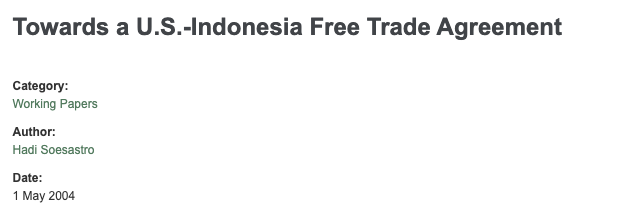U.S.-Indonesia Trade Agreement: A New Economic Framework

The U.S.-Indonesia Trade Agreement marks a significant milestone in enhancing economic relations between the two nations. With Jakarta poised to eliminate nearly all Indonesia tariffs on American goods, this bilateral trade agreement aims to foster a more balanced trade framework. As the U.S. implements a 19% tax on imports from Indonesia, it sets the stage for a strong revival of trade partnerships under the current U.S. trade policy. This pivotal agreement not only boosts access for U.S. producers but also addresses non-tariff barriers, promising to pave the way for expansive market opportunities. As these negotiations unfold, the implications for both economies could redefine their trade landscape well into the future.
In recent developments, the framework for U.S.-Indonesia trade encapsulates a comprehensive strategy geared towards mutual economic growth. The newly established mutual trade pact signifies a robust commitment to reducing barriers and increasing market fluidity between these two vibrant economies. Indonesia, as a vital participant in global trade, is set to enhance its transactions with America, navigating through tariffs that impact import and export dynamics. This economic partnership aims to unlock potential across diverse sectors while addressing existing challenges in cross-border commerce. As both nations embark on finalizing this trade initiative, they are keen on fostering a collaborative environment that can lead to sustainable economic benefits.
Understanding the U.S.-Indonesia Trade Agreement
The U.S.-Indonesia Trade Agreement marks a significant milestone in strengthening economic relations between the two nations. With Indonesia’s commitment to eliminate nearly all tariffs on U.S. goods, this framework opens up opportunities for American businesses to expand their footprint in Indonesian markets. The agreement aligns with the broader goals of U.S. trade policy which seeks to promote fair trade practices while nurturing domestic industries. With the prospect of reduced tariffs, it paves the way for increased exports and investment opportunities.
This trade framework aims to foster not only economic cooperation but also to address non-tariff barriers that have hindered U.S. exports to Indonesia. The negotiation of the Agreement on Reciprocal Trade is a testament to both countries’ resolve to enhance bilateral trade relations. As the U.S. seeks to mitigate its trade deficit, the agreement is poised to facilitate smoother access for American companies, particularly in sectors like technology and energy, where Indonesia is increasingly demanding foreign investments.
Frequently Asked Questions
What is the U.S.-Indonesia Trade Agreement and what does it involve?
The U.S.-Indonesia Trade Agreement is a bilateral trade framework aimed at enhancing economic relations between the two countries. It involves Indonesia eliminating nearly all tariffs on U.S. goods, while the U.S. will establish a 19% tariff on imports from Indonesia. The agreement also addresses non-tariff barriers, aiming to improve market access for U.S. producers.
How will the U.S.-Indonesia Trade Agreement impact tariffs on U.S. goods?
Under the U.S.-Indonesia Trade Agreement, Indonesia will remove most tariffs on U.S. goods, allowing for greater access to its markets. This is a significant shift given the previous high tariffs faced by American exporters.
What are the expected benefits of the U.S.-Indonesia Trade Agreement for American businesses?
American businesses stand to benefit greatly from the U.S.-Indonesia Trade Agreement as it opens the Indonesian market by reducing tariffs and non-tariff barriers. This agreement is expected to enhance access for U.S. companies in sectors like digital services and energy.
What are the future steps for the U.S.-Indonesia Trade Agreement?
Following the announcement of the U.S.-Indonesia Trade Agreement, both nations will continue to negotiate and finalize the Agreement on Reciprocal Trade. They will prepare the necessary formalities for domestic enforcement before the agreement is signed.
How does the U.S.-Indonesia Trade Agreement fit into U.S. trade policy?
The U.S.-Indonesia Trade Agreement is a key component of the U.S. trade policy aimed at securing favorable economic relations with strategic partners, and it follows a similar approach taken with other nations under the previous administration. It intends to protect U.S. producers while ensuring competitive access to Indonesian markets.
What is the significance of the tariffs set in the U.S.-Indonesia Trade Agreement?
In the U.S.-Indonesia Trade Agreement, the tariff on Indonesian imports is pegged at 19%, which is significantly lower than the 32% imposed previously. This marks a positive shift towards promoting bilateral trade and addressing long-standing tariff challenges.
How does the U.S.-Indonesia Trade Agreement affect U.S.-Indonesia economic relations?
The U.S.-Indonesia Trade Agreement aims to strengthen economic relations by facilitating increased trade volume, which has already reached over $38 billion annually. The agreement is likely to enhance cooperation in various sectors, thus bolstering both economies and fostering better relations.
What are some key commercial projects included in the U.S.-Indonesia Trade Agreement framework?
The U.S.-Indonesia Trade Agreement framework includes significant commercial projects, such as a $3.2 billion aircraft purchase and $15 billion in energy product acquisitions, indicating a commitment to expanding trade relations beyond just tariff adjustments.
What challenges have U.S. producers faced in Indonesian markets prior to the U.S.-Indonesia Trade Agreement?
Prior to the U.S.-Indonesia Trade Agreement, U.S. producers faced high tariffs and excessive requirements in Indonesian markets, which hindered market entry. The new agreement aims to rectify these non-tariff barriers, facilitating smoother business operations.
Is the U.S.-Indonesia Trade Agreement part of a larger strategy by the U.S. government?
Yes, the U.S.-Indonesia Trade Agreement is part of a broader strategy by the U.S. government to establish trade frameworks with multiple countries, similar to agreements made with the UK, China, Vietnam, and the Philippines under recent trade policies.
| Key Points | Details |
|---|---|
| Trade Framework Agreement | The U.S. and Indonesia reached a trade framework agreement, aiming to enhance bilateral trade relations. |
| Tariff Reductions | Indonesia will eliminate nearly all tariffs on U.S. goods, while the U.S. will impose a 19% tariff on imports from Indonesia. |
| Negotiations | Both nations will negotiate and finalize the Agreement on Reciprocal Trade over the next few weeks. |
| Key Commercial Agreements | The agreement includes significant commercial agreements, such as a $3.2 billion aircraft purchase and a $15 billion energy product acquisition. |
| Non-Tariff Barriers | The framework addresses non-tariff barriers and other market challenges facing U.S. exports to Indonesia. |
| Current Trade Status | Indonesia is a top 25 trade partner of the U.S., with trade exceeding $38 billion in goods for 2024. |
| Trade Deficit | The U.S. reported a trade deficit of $17.9 billion with Indonesia last year. |
| Strategic Importance | U.S. Trade Representative highlights potential for American producers to gain market access in Indonesia. |
Summary
The U.S.-Indonesia Trade Agreement marks a significant advancement in trade relations between the two countries, aiming to eliminate tariffs and increase mutual market access. This framework will not only benefit U.S. exporters by reducing previous tariffs but also ensure a stronger commercial partnership moving forward. The ongoing negotiations signal promising developments in trade opportunities, especially in sectors like energy and aviation, while addressing existing market challenges. Overall, this agreement represents a strategic step toward optimizing U.S. trade dynamics in Southeast Asia.




